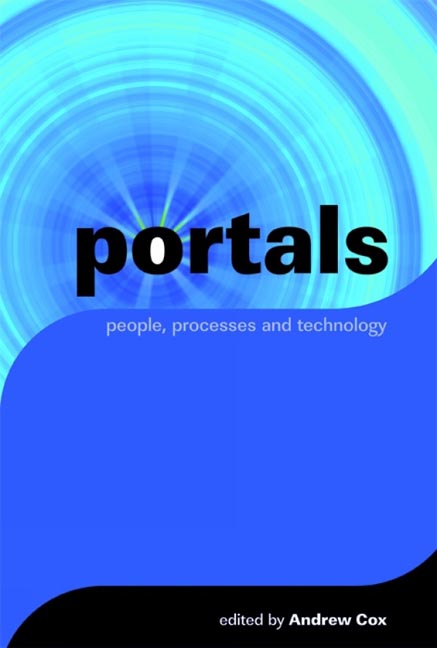Book contents
- Frontmatter
- Contents
- Introductory preface
- Section 1 Core themes
- 1 Definitions and debates
- 2 Portals or filters? Identifying quality on the internet
- 3 Portal architectures
- 4 Personalization initiatives in the public and academic domains
- 5 User needs analysis and evaluation of portals
- 6 Managing portal services
- Section 2 The library and the portal
- Section 3 The portal in the corporate sector
- Section 4 Portals in the public sector
- Section 5 The future
- The contributors
- Index
5 - User needs analysis and evaluation of portals
from Section 1 - Core themes
Published online by Cambridge University Press: 09 June 2018
- Frontmatter
- Contents
- Introductory preface
- Section 1 Core themes
- 1 Definitions and debates
- 2 Portals or filters? Identifying quality on the internet
- 3 Portal architectures
- 4 Personalization initiatives in the public and academic domains
- 5 User needs analysis and evaluation of portals
- 6 Managing portal services
- Section 2 The library and the portal
- Section 3 The portal in the corporate sector
- Section 4 Portals in the public sector
- Section 5 The future
- The contributors
- Index
Summary
Introduction
As specified in the ISO 13407 standard (ISO, 1999), user-centred design begins with a thorough understanding of the needs and requirements of the users. User needs analysis (or knowledge elicitation) and evaluation methods in human–computer interaction (HCI) are a critical function to the success of requirements and design gathering (Maiden, Mistry and Sutcliffe, 1995), usability testing and user evaluation stages of software development (Zaphiris and Kurniawan, 2001).
Examples of knowledge elicitation methods often start with initial questionnaire for feedback, requirements task walkthroughs, interviews techniques and focus group sessions (discussed in further detail in a subsequent section). It can rapidly scale upwards to more complex psychometric, design and evaluation processes: prototype construction of various fidelity levels, direct and indirect observation practices for monitoring user actions, response time comparisons, and various methods for eliciting mental categorization models, e.g. for distinguishing patterns of use between experts and non experts.
The measure of a good experience can vary from person to person; however the appropriate understanding of a usable design comes from gaining the knowledge that it is functional, efficient and desirable to its intended audience (Kuniavksy, 2003). John and Marks (1997) identify three key factors to assess the usability of an interface:
Usability is measured by the extent to which the intended goals of use of the overall system are achieved (effectiveness); the resources that have to be expended to achieve the intended goals (efficiency); and the extent to which the user finds the overall system acceptable (satisfaction).
The usability of a system is also related to issues surrounding its accessibility. There is a broad range of users to whom web-based services are directed, and the services provided ought to be accessible to them (e.g. the visually, hearing, physically or cognitively impaired or even people with different experience of and attitudes towards technology).
The Disability Discrimination Act (DDA) began to come into effect in the UK in December 1996 and brought in measures to prevent discrimination against people on the basis of disability. Part III of the Act, in force since October 2004, aims to ensure that disabled people have equal access to products and services.
- Type
- Chapter
- Information
- Portalspeople, processes and technology, pp. 52 - 62Publisher: FacetPrint publication year: 2006
- 1
- Cited by

